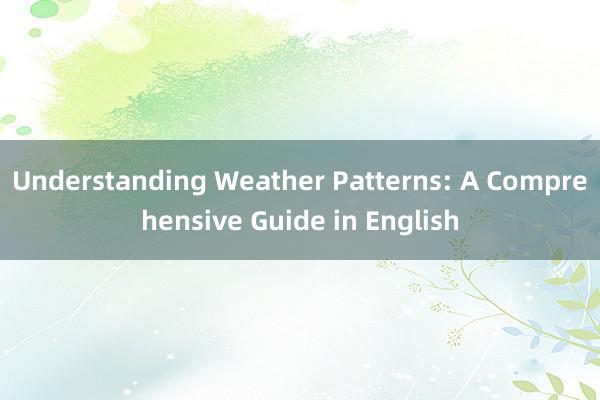时间:2024-10-18 16:25

# Understanding Weather Patterns: A Comprehensive Guide in English
Weather patterns are the recurring and predictable atmospheric conditions that characterize different regions over time. These patterns can be influenced by various factors such as geographical location, altitude, and proximity to water bodies, leading to diverse weather phenomena around the globe. Understanding these patterns is crucial for agriculture, navigation, tourism, and disaster management. In this guide, we will explore the fundamental concepts of weather patterns, their types, and how they affect our daily lives.
## **Fundamentals of Weather Patterns**
### **Temperature and Pressure**
- **Temperature** refers to the average kinetic energy of the particles in a substance. Warm temperatures typically lead to higher air pressure at lower altitudes, while cooler temperatures result in lower pressure.
- **Pressure** is the force exerted per unit area by the weight of the air above. High-pressure systems usually bring clear skies and stable weather, whereas low-pressure systems are associated with stormy weather due to the convergence of air masses.
### **Wind**
Wind is the movement of air from high-pressure areas to low-pressure areas. The direction and speed of wind are influenced by temperature gradients and the rotation of the Earth (Coriolis effect). Understanding wind patterns helps in predicting weather changes and planning outdoor activities.
### **Humidity**
Humidity measures the amount of water vapor present in the air. It affects the comfort level of humans and animals, influences cloud formation, and can impact crop growth. High humidity often leads to increased moisture content in the air, which can contribute to fog, dew, and precipitation.
## **Types of Weather Patterns**
### **Fronts**
- **Cold Fronts**: Occur when a cold air mass replaces a warm one. They are associated with sharp temperature drops, high winds,深圳一鸿盛商贸有限公司 and precipitation.
- **Warm Fronts**: Happen when a warm air mass moves into an area with colder air. These fronts are generally smoother and can bring milder temperatures and precipitation.
- **Stationary Fronts**: Occur when two air masses of similar temperature and humidity meet and neither can displace the other. This can lead to prolonged periods of rain or thunderstorms.
### **Cyclones and Anticyclones**
- **Cyclones** (also known as hurricanes or typhoons) are low-pressure systems characterized by rotating winds that move in a counterclockwise direction in the Northern Hemisphere and clockwise in the Southern Hemisphere. They are associated with heavy rainfall, strong winds, and storm surges.
- **Anticyclones** are high-pressure systems with clockwise rotation in the Northern Hemisphere and counterclockwise in the Southern Hemisphere. They are typically associated with fair weather, calm winds, and clear skies.
### **Monsoons**
Monsoon systems are characterized by seasonal reversals of wind direction, bringing large amounts of moisture to regions that would otherwise have little rainfall. They play a crucial role in the agricultural cycles of many countries, particularly in Asia.
## **Impact on Daily Life**
Weather patterns significantly influence human activities and natural processes. For instance:
- **Agriculture** relies heavily on weather forecasts to plan planting, irrigation, and harvesting times.
- **Navigation** requires accurate weather predictions to ensure safe travel and avoid hazards like storms and fog.
- **Tourism** is greatly affected by weather conditions, influencing decisions on destinations and activities.
- **Disaster Management** depends on understanding and predicting extreme weather events like hurricanes, floods, and droughts to prepare and mitigate potential impacts.
In conclusion, understanding weather patterns is not only essential for scientific study but also for practical applications in everyday life. By recognizing the underlying principles and types of weather phenomena, individuals and communities can better prepare for and adapt to changing weather conditions, ensuring safety, efficiency, and sustainability.